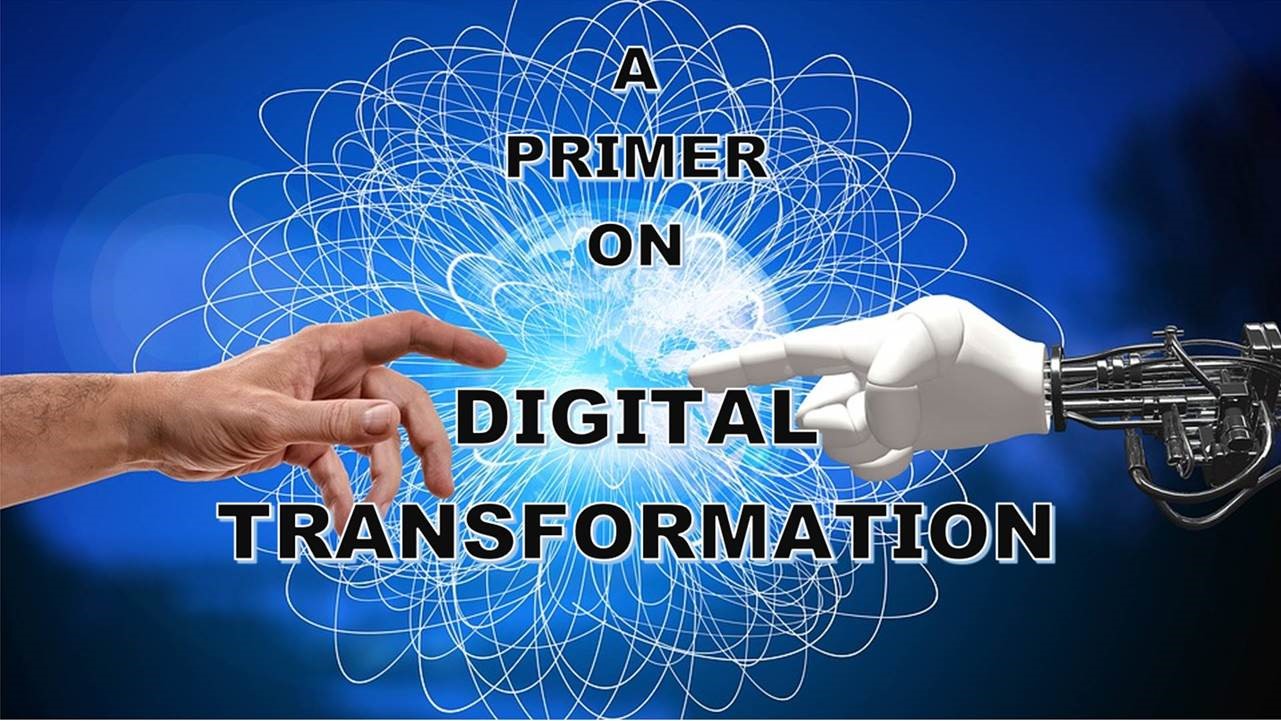In this article, we attempt to offer an executive summary of digital transformation for the industry practitioners to help them navigate through complexities of digital transformation. The article includes the essence of digital transformation, pillars of digital transformation, driving forces and critical success factors of digital transformation with a few examples of success and failure of digital transformation.
Introduction
Digital Transformation (DX) – the notion that took business by storm over the past few years is a key topic on the minds of C-suite executives across any industry. There has been a lot of buzz around DX. Technology industry as a whole and CXOs are grappling with the hype and reality of digital transformation. Surprisingly, academics and practitioners share common ground – DX is the ultimate survival recipe in today’s complex, competitive and dynamic business world, particularly in a post-pandemic economy – so what is Digital Transformation?
Digital Transformation
With the advent of higher computing power following Moore’s Law, lower price-performance ratio of storage and high-speed connectivity, there’s a phenomenal change in the business world. The confluence of these elements led to the inception of the fourth industrial revolution or ‘Digital Transformation’ – an all-encompassing and multi-dimensional transformation of organizational operations, products & services, competencies, business model, employee experiences and holistic customer journey by utilizing digital technology as an enabler. Charles Araujo, Founder of the Institute for Digital Transformation puts it precisely: “Digital transformation is the fundamental shift in nature of value creation through differentiated experience – therefore organizations should continually re-orient and transform themselves to create and sustain that experience.” [1] Joanne Friedman, CEO of Connektedminds, echoed similar opinion: “Any company that isn’t constantly in some state of transformation isn’t alive.” [2] Accenture CIO, Andrew Wilson as well as Deloitte research leads, Garth Andrus and Anh Phillips went one step further by defining DX as more about people, human and cultural transformation than technology transformation. [3] So what are the pillars of DX?
Pillars of Digital Transformation
Although technology plays a pivotal role in driving digital strategy and digital journey, it can be safely concluded from the above mentioned viewpoints by the thought leaders in this arena that digital transformation is not about technology or IT projects to automate or optimize business or technology processes incrementally similar to digitization or digitalization that we have seen in the past. However, digital transformation is an aggregate of comprehensive cultural transformation, organizational or structural transformation and technology transformation across the organization [1] – the “pillars of digital transformation” across three key areas – the trifecta of any enterprise that includes “customer experience to reexamine customer journey, operational processes to build resiliency and business models for growth”, asserted by Westerman et al. [4]
Interestingly enough, there’s no universal agreement on the core pillars and elements of digital transformation among the industry practitioners and academic community. Nevertheless, there is some level of unanimity on the aforementioned core pillars of digital transformation and the following elements within the pillars at a broader level across all sectors.
Cultural Transformation
Organizational and cultural elements help firms realize resiliency dividend. [5] Indeed, the following elements within the cultural transformation pillar are the table stakes for any institutions to be successful in this digital era:
- Changing mindset to drive new ways of thinking
- Customer-centric mindset
- Breaking down cultural inertia
- Fostering and perpetuating strong employee digital experience by reskilling, upskilling and new ways of working
- Collaborative and agile culture of delivery with digital agility
- Building trust as well as psychologically safe and risk-taking environment for experimentation with the notion of ‘fail fast and relearn’ from ‘minimal viable product’ (MVP)
Structural Transformation
In addition to the cultural components, David Rogers, Columbia Business School faculty, puts forward certain organizational and strategic constructs that act as the structural pillars of digital transformation [6]:
- Dynamic network of customers and engagement thereof through hybrid channels and digitized solutions to redefine customer journey
- Shared platform business model among the partners to achieve asymmetric competition and coopetition
- Data as currency, strategic asset and source of value creation
- Driving new value proposition by tapping into digital ecosystem as a source of innovation
- Tearing down structural siloes to create cross-functional teams
- Striking right balance between legacy and modern platforms to revamp your operational backbone to achieve operational resiliency and reliability
- Digital-savvy and forward-looking leadership with digital vision and high emotional intelligence
- Organizational ambidexterity to exploit and explore simultaneously – traditional exploited units might be separated from the exploratory units at the low level but tightly linked across the units at the senior executive level [13]
Technology Transformation
Last but not least, technology transformation consists of digital and disruptive technology that act as the underpinning of digital transformation. Today “digital” means different to different people and organizations. Nonetheless, there is a general consensus on the definition of “digital” – that is, “digital” represents a set of technology:
- Technologies and innovation of ‘Third Platform’ (coined by IDC) or ‘Nexus of Forces’ (coined by Gartner) that include Cloud enablement, Mobile computing, Social media, Big-data analytics along with RPA and API adoption [7]
- Technologies of ‘fourth platform’ such as AI, Cognitive computing, AR/VR, IOT, Robotics, Blockchain, 5G and even quantum computing at the current moment [8]
Drivers of Digital Transformation
So why is digital transformation so important in today’s post-pandemic digital age? What are the drivers of digital transformation?
Interestingly, it has been predicted by IDC that digital transformation global spending will reach a whopping $6.8 trillion globally with a healthy CAGR of 15.5% by 2023. [9] Furthermore, IDC forecasted that 65% of the world’s GDP would be digitized by 2022 due to recent COVID-19 pandemic that upended all sectors of business and precipitated digital transformation. BCG points out that digital organization leaders achieved 1.8 times higher earnings growth than digital laggards, and more than double the growth in enterprise value. [5] With that in mind, the following are the primary driving forces of digital transformation:
- The extraordinary pace of technological change that drives acceleration of disruption and innovative business models in an unprecedented manner
- Radically changing consumer behavior in post-COVID age in order to fight back the global pandemic, reset and adapt to the new normal
- Shifting demographics – with the rapid growth of millennials in the digital world – the generation that gravitates towards digital and digital business.
- Increased competition from digital natives and challengers due to low barriers to entry across sectors
Critical Success Factors of Digital Transformation
Companies across the industries realize that digital transformation is a continuous journey, and that DX is more difficult than traditional transformation. However, there are some overarching benefits of a successful digital transformation that range from increased efficiency, higher productivity, greater operational resiliency, improved innovation, faster time to market and higher growth. In any event, the efficacy as well as critical success factors of digital journey is contingent on the transformation of some of the above mentioned critical elements of the digital transformation pillars along with a few additional strategic dimensions:
- Integrated strategy with clear business transformation goals is one of the determining criteria for highly effective digital transformation. Digital agenda should be brought under the mainstream investment rather than a siloed undertaking, and digital journey should be grounded in the organization’s overall strategy and customer demands to achieve positive return of investment (ROI) and stay ahead of the disruptive curve. Case in point, GE and a few others failed in achieving digital transformation because GE created a separate digital business from its legacy and core business resulting in lack of balance between the digital capabilities and core business needs. [10]
- Leadership commitment from the top C-suite through middle management with well-articulated vision and defined purpose is a crucial success criterion to digital transformation success. In reality, commitment across leadership hierarchy brings employees on board and promotes positive behavior towards change and innovation across the organization. [11]
- Disciplined adoption of next-gen digital technology and agile delivery help organizations redefine competitive advantage. For an example, with the implementation of emerging technology, BMW now allows customers to buy cars individually, while enabling the customers to configure entirely online and have them delivered to them – thus recreating a seamless customer journey. Domino’s Pizza is another perfect example of digital transformation success; the firm pulled off technology-driven transformation by overhauling their entire infrastructure and using AI and machine learning as primary levers to improve product quality and hybrid operations. [12]
- Digital culture as well as acquisition of high-caliber digital talent and empowerment of people to work in new ways improve digital maturity of the organizations. Capital One is a quintessential example of successful digital transformation in this category. The firm built digital talent, agile and DevOps practices, and accelerated customer-centric innovation using digital technology. [11]
- Continuous transformation of the underlying operating model, structure and organizational behavior conducive to lean and agile journey will equip organizations to set the stage for innovation and digital transformation. Anthem, a healthcare company was able to successfully achieve digital transformation through building agile structure with the right talent and leadership. Similarly, Walmart embarked on a multi-pronged digital transformation with business re-platforming, forging strategic partnerships with multiple technology vendors, digitalizing supply chain, customer service and store operations in an effort to revamp hybrid customer experience.
- Additionally, firms will be able to successfully manage digital transformation efforts by effectively monitoring and measuring progress towards defined outcome.
- Lastly, organizations will be truly able to overcome speed bump and manage overall complexity of digital transformation voyage amid rapidly changing regulatory landscape by institutionalizing digital governance – essentially, by building effective change management with the right set of KPI’s and adaptive Governance Risk & Compliance (GRC) strategy with digital Center of Excellence (COE), while establishing enterprise architecture and developing elastic cost structure – fundamentally, building the digital operating model of 21st century in a post COVID world. [11]
Conclusion
In closing, it can be argued that digital transformation journey will continue to equip organizations with the framework to survive, thrive and compete in this global economy in an unparalleled manner. Consequently, industry leaders and practitioners at all levels should consider the cultural, structural and technology transformation pillars of DX across key areas of customer engagement, operational processes and business model, driven by ever-changing technology ecosystem, consumer behavior and demographics; the leaders should nurture the elements of the pillars continuously in all phases of digital transformation to build organizational agility and ensure that innovation is ingrained in the organizational DNA, particularly in a post pandemic era. Additionally, in times of crisis, digital transformation will enable CXOs to re-imagine business model, re-evaluate value chain and reconnect with customers in an unprecedented manner.
References
- Industrialisation against Digital Transformation – Charles Araujo
- Redefining Digital Transformation with Connektedminds’ CEO, Joanne Friedman
- The Technology Fallacy: How people are the real key to digital transformation
- The Nine Elements of Digital Transformation
- Is Your Technology Ready for the New Digital Reality?
- The Digital Transformation Playbook
- Nexus Of Forces
- The Essential Eight technologies that matter most for business today
- Digital Transformation Investments to Top $6.8 Trillion Globally as Businesses & Governments Prepare for the Next Normal
- Companies Can Flip the Odds of Success in Digital Transformations from 30% to 80%
- THE FIVE IMPERATIVES OF A SUCCESSFUL DIGITAL TRANSFORMATION
- BMW invests ‘hundreds of millions’ in digital transformation
- The Ambidextrous Organization
- Unlocking success in digital transformations
About the Author
 Paul Pal is an accomplished technology executive and a thought leader in the digital strategy. With a proven track record of over 23 years of progressive experience & broad knowledge in technology and business domains, Paul leads multi-million-dollar strategic digital transformation initiatives. Additionally, through integrity, credibility & sound business ethics, he builds trust, drives customer journey and achieves ROI.
Paul Pal is an accomplished technology executive and a thought leader in the digital strategy. With a proven track record of over 23 years of progressive experience & broad knowledge in technology and business domains, Paul leads multi-million-dollar strategic digital transformation initiatives. Additionally, through integrity, credibility & sound business ethics, he builds trust, drives customer journey and achieves ROI.
Currently, Paul serves as the CTO, Chief Technologist at DXC Technology, and oversees a segment of Banking and Capital Markets tower in North Americas region. In this role, Paul is accountable for growing strategic accounts and building internal digital transformation practice – that includes enterprise architecture, cloud enablement and governance, software engineering with DevOps culture, big data analytics and infrastructure build. Furthermore, he has held leadership roles and executive positions in leading financial institutions as well in the past.
Paul holds an MBA from Cornell University and M.S. in Information Systems from New Jersey Institute of Technology.
Tag/s:Digital EnterpriseDigital EraPersonal Development








Thanks for coming up with this primer on digital transformation, Paul. This is very useful. While a Digital Assurance strategy is a composite of many factors, there are three new entrants into what is an already crowded lineup of critical enablers for digital transformation: real time experience monitoring, automation of data validation and, thinking forward, (yes, it is really coming) 5G network adoption. Peeling away a few more layers of the digital transformation onion, these have taken an increased relevance in the journey to digital success.